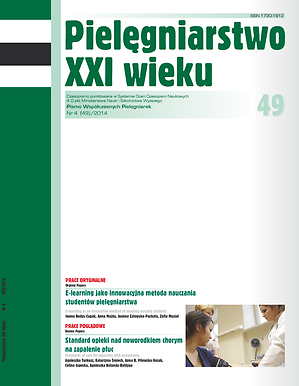Zaawansowana praktyka pielęgniarska w Stanach Zjednoczonych Ameryki
Słowa kluczowe:
zaawansowana praktyka pielęgniarska, rozwój, edukacja, kompetencje, USAAbstrakt
Celem pracy jest przedstawienie historii rozwoju i drogi edukacyjnej klinicznie zaawansowanego pielęgniarstwa (Advanced Nurse Practitiner ANP) w Stanach Zjednoczonych Ameryki Północnej. Ukazuje także znaczenie tego typu kształcenia w reformie zdrowotnej w USA, której istotą jest zapewnienie dostępności do opieki zdrowotnej każdemu obywatelowi z uwzględnieniem niższych kosztów przy jednoczesnym zachowaniu standardów leczenia porównywalnych do tych, które są świadczone przez lekarzy pracujących w podstawowej opiece zdrowotnej
Praca ukazuje zasadnicze elementy, które charakteryzują zaawansowaną praktykę pielęgniarską. Pielęgniarki klinicznie zaawansowanej praktyki są liderami w rozwoju pielęgniarstwa i stanowią grunt w zapewnieniu rozwoju klinicznego. Ich zaangażowanie zawodowe, wiedza kliniczna, wysoki standard opieki oraz prestiż społeczno-zawodowy, mają wpływ na decyzje kliniczne i politykę zdrowotną. Zaawansowana praktyka pielęgniarska obejmuje orzecznictwo w sprawach zdrowia, obniżenie kosztów leczenia społeczeństwa, rozszerzenie zasięgu opieki zdrowotnej, skuteczną profilaktykę chorób i proklamację zdrowia, leczenie podstawowych schorzeń klinicznych z uwzględnieniem idei holizmu. Wszystkie te elementy składają się na pełny wymiar opieki klinicznej, obejmującej sferę fizyczną i psychiczną pacjenta, do której pielęgniarka klinicznej zaawansowanej praktyki jest świetnie przygotowana w ramach studiów pielęgniarskich i dodatkowych form kształcenia.
Bibliografia
1. Buppert C. Nurse Practitioner’s Business Practice and Legal Guide (4th ed.). Sudbury, MA: Jones and Bartlett Learning, LLC; 2012.
2. APRN Joint Dialogue Group. Consensus Model for APRN Regulation: Licensure, Accreditation, Certification & Education. 2008. On-line.
3. http://pdf.tutorial6.com/c/consensus-model-for-aprn-regulation-licensure-w35944.html - 30.09.2014. Medscape, History of Nurse Practitioner; 2006. On-line. http://www.medscape.com/viewarticle/464663_2 - - 30.09.2014.
4. National Council of State Boards of Nursing. Uniform Advanced Practice Registered Nurse Licensure/Authority to Practice Requirements. Chicago: Author.2002. On-line. http://www.aacn.org/WD/CETests/Media/ACC2212.pdf – 02.10.2014.
5. Mundinger, M.O., Kane, R.L., Lenz, E..R., et al. Primary care outcomes in patients treated by nurse practitioners or physicians. JAMA. 2000; 283:59-68. On-line. www.unboundmedicine.com/evidence/ub/citation/10632281/ – 02.10.2014.
6. Naylor MD, Kurtzman ET. The Role of Nurse Practitioners in Reinventing Primary Care. Health Affairs. 2010, 29(5): 893-99.
7. Horrocks S, Anderson E, Salisbury C. Systematic Review of Whether Nurse Practitioners Working in Primary Care Can Provide Equivalent Care to Doctors BMJ. 2002; 324 (7341): 819-23. On-line. doi: http://dx.doi.org/10.1136/bmj.324.7341.819 – 26.08.2014.
8. U.S.A. Department of Health & Human Services. The Number of Nurse Practitioners and Physician Assistants Practicing Primary Care in the United States Primary Care Workforce Facts and Stats No. 2. On-line. http://www.ahrq.gov/research/findings/factsheets/primary/pcwork2/index.html – 02.10.2014.
9. Kohr R. Advanced practice role confusion: What’s the solution? Canadian Nurse. 1998: 94(6): 30-33.
10. Cadina Leik M. Adult-Gerontology Nurse Practitioner Certification Intensive Review (2nd ed). Springer Publishing Company New York; 2013.
Pobrania
Opublikowane
Numer
Dział
Licencja
Prawa autorskie (c) 2014 Autorzy

Utwór dostępny jest na licencji Creative Commons Uznanie autorstwa 4.0 Międzynarodowe.




